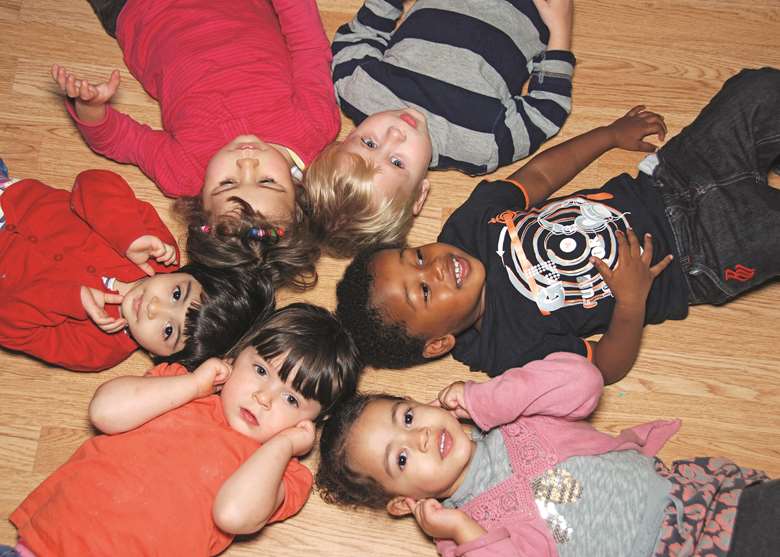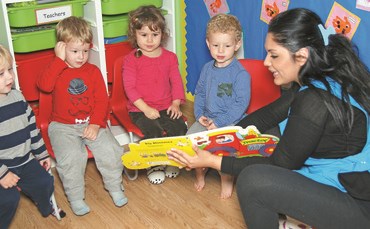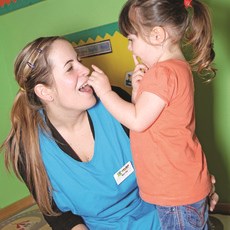Learning & Development: Two-year-olds: Part 11- So to speak
Ruth Thomson
Monday, November 4, 2013
Almost every early years setting has children who speak languages other than English at home. But what approaches can practitioners use to best support multilingual learning? Penny Tassoni reports.

Twenty years ago, most children in early years settings - with the exception of London and some other large cities - were monolingual. Today, most early years settings are likely to have children who speak a language other than English with their parents. So how do two-year-olds learn more than one language and how can we best support them to develop strong communication skills?
The starting point when looking at children who have the opportunity to learn multiple languages is to view it as a cause for celebration. These children are very lucky and they should in no way be seen as a 'problem'.
Being able to communicate in more than one language not only allows children to build relationships with family members and understand their cultural inheritance, but positively affects brain development.
Years ago, the received wisdom was that additional languages put children at a disadvantage, but research now clearly shows that the opposite is true. Early language learning seems to enhance cognitive function and may even reduce the risk of dementia in old age.
MULTILINGUAL LEARNING
The process by which children learn more than one language is actually quite simple. As with monolingual learning, it is all about exposure and meaningful interactions, with words and phrases being learned in context. Each language is a code and in order to 'break' the code and then go on to use it many children will often associate each language or code with a person or context.
Learning the rules of grammar and syntax happens in the same way as learning a single language at a young age, because it would seem that nature 'primes' children's brains to work these out.
So when two-year-olds arrive in your setting without any English, they will eventually link the use of English to being in the setting, playing with other children and talking to their key person, while at home responding to the home language.

SETTLING IN
As with all other two-year-olds, the first step is to ensure that these children are properly settled and that they develop a strong relationship with their key person. As part of the settling-in process, we need to find out which languages are used at home and also whether the child has had any exposure to English. Making any assumptions at this point is dangerous; just because a child's parent has excellent English does not mean that the child has heard much English before.
Equally, a child whose parent has very limited English may have spent some time with an English speaking nanny, childminder or family member and so their language development may be similar to the other two-year-olds.
While coming into a new setting may be overwhelming for any child, special care needs to be taken for those children to whom the sounds of English are totally new. They have been plunged not only into an unknown environment but also a new soundscape. It is pretty usual for these children to cling closely to their key person. This should never be discouraged because it will be mainly as a result of being with the key person that these two-year-olds will develop English.
LANGUAGE GUIDE
In some ways, the role of the key person is to be a language guide for the child. At first, this means establishing a strong relationship with children, as the sooner they are comfortable with us the quicker they will tune into the code of English.
There are no set rules as to how to build relationships with children, but friendly eye contact and gestures, soft spoken words and a willingness to spend time attempting to understand what the child is trying to express and communicate through their non-verbal communications seem to be important.
To help the child express their needs and interests during this time, think about using photographs and pictures and be ready to be led by the child to a particular activity or place in your setting.
BREAKING THE CODE
Once you are on good communicating terms with children, you need to help them break the code of English. This is usually done by pointing out an object to a child and then naming it within a simple sentence.
The style is quite repetitive and is in many ways similar to the one used when promoting babies' language. It may sound something like this: 'Look, Ayse - BOTTLE. Shall we fill the BOTTLE with water? Do you want to hold the BOTTLE? Let's fill the BOTTLE up!'
As well as doing this through play, we can also help two-year-olds to learn the meanings of words using simple books. Some of the best books to start with are baby books or books with a very obvious plot. It can also be a good idea to make picture books that reflect your setting. As lift-the-flap books are especially popular with this age group, think about creating one with photographs of you and the child in different areas of the setting.
SILENT PERIOD
As with language development in babies, there is a time lag between a child understanding the meaning of a word or phrase and their using it. This is normal and the advice is never to push a child to speak until they do so freely.
The length of time it takes a child to say a few words is very variable. It depends on their relationship with the adult, their personality and also how familiar they are with the situation they are in.
During this 'silent period', conversations can feel a little one sided to say the least, but as long as the child seems happy and is responding in some way, all is well. In terms of assessment of language, count the key words that the child seems to respond to, such as 'coat' or 'snack'.
LANGUAGE ROUTINES
 Some of children's first words appear during familiar routines when the same words and phrases are used over and over again. Most first words come as children relax into a situation and a word slips out fairly effortlessly. To encourage this, try to create some little routines between you and the child. You may, for example, always say 'Hello' to the cook, or go over to a fish tank and feed the fish.
Some of children's first words appear during familiar routines when the same words and phrases are used over and over again. Most first words come as children relax into a situation and a word slips out fairly effortlessly. To encourage this, try to create some little routines between you and the child. You may, for example, always say 'Hello' to the cook, or go over to a fish tank and feed the fish.
Whatever the routine that you develop, the key is to use similar phrases and words each time so that the child can eventually join in. This is quite intensive work, but it pays off as it speeds up their pathway into English. If you have several two-year-olds who need this type of support, you can create these small routines for pairs of children.
SPEECH DELAY
There are plenty of myths around multilingualism. One of these is that children are bound to be delayed in their speech if they are learning more than one language, especially from birth. This is not usually the case, particularly where each language is being used consistently so that children can separate each code and associate it to a person or context.
Where there are concerns about a child's language development, it is important to seek a referral, especially if parents say that their child is not talking in the home language at home. This is important because sometimes there may be other underlying reasons why a child is not making progress, such as a learning difficulty or a hearing loss.
RATE OF PROGRESS
Exposure and meaningful interactions are essential for children to make progress in English. So when considering whether a child is making sufficient progress or whether a referral is needed, think firstly about how many hours the child has spent 'in English'.
If a two-year-old has been attending for a month, but only for one session a week, their rate of progress will be significantly slower than another two-year-old who attends every day. They will, however, eventually break the code and use the code, but over a longer period.
As well as considering the amount of exposure, think about how much time a child spends in play and activities that allow for meaningful interaction. A two-year-old who spends most of the session engaged in solitary or parallel play may be enjoying the session, but might not be getting sufficient opportunities to learn the code of English. If this were the case, the first step might be to ensure that the child is engaging more often with their key person.
SUBSTITUTION OF WORDS
One of the great fears of parents and practitioners is that children will confuse languages. While you should always refer children who are not making progress in either language, do not worry if a child sometimes substitutes a word from their home language and uses it.
This is pretty normal and just means that the child does not yet know that word in English. If it happens, acknowledge the child's communication positively and point to the object and say the word in English as part of a simple sentence.
SUPPORTING THE HOME LANGUAGE
Finally, there is a requirement in the Early Years Foundation Stage for settings to support children's home language. This may seem daunting if you do not know the language, but it is actually very important - especially for children who may spend more time exposed to English than their home language.
The need for exposure to the home language means that it is not considered a good idea to suggest to parents that they talk to their child in English if they wish their child to become fluent in the home language.
So what can you do if you do not speak, or have access to an adult who can speak, the child's language?
The good news is that technology can help out here, allowing children to hear words and sentences in their home language. While this is never as good as meaningful interaction between an adult and a child, it is far better than nothing.
Look out for computer programmes, talking books and resources such as 'magic pens'. Magic pens are devices that allow books to be read in the child's language. When the magic pen is put on the book, it 'reads' the sentences.
Magic pens are recordable devices, so parents could also use them to 'read' to their child in their absence. Hearing words accurately spoken in the child's language has the added advantage of helping you to pick up key words and pronounce them well. The need for correct inflection is particularly important in certain languages such as Chinese, where one word may have several meanings depending on the inflection used.
SHARED EXPERIENCES
It is good practice for settings to share photographs or film clips of children with parents, and this is particularly important when it comes to helping multilingualism.
Visual images of what the child has done in the setting not only acts as a good communication tool between the setting and home but allows the child to learn the vocabulary associated with the images in their home language.
A child whose home language is Turkish may know the word 'sand'
in English, but may not know its equivalent in Turkish (kum), given that - as we saw earlier - children pick up vocabulary according to context and not all parents will have sand at home.
OBSERVATION POINTS
- Does the child seem settled and happy?
- Does the child attempt communication by pointing or through facial expressions?
- Are there any phrases or words used in the routine that the child seems to recognise - for example, 'snack'?
- Does the child join in with any songs?
- Does the child vocalise or say any words or phrases?
- What seems to be of interest to the child?
SKILLS INTO PRACTICE
- Avoid talking loudly, as this distorts voice tones
- Point to objects before naming them
- Use high levels of facial expression
- Don't expect children to vocalise immediately
- Use pictures and photos to aid communication
- Do not correct children's speech, but repeat back correctly.




